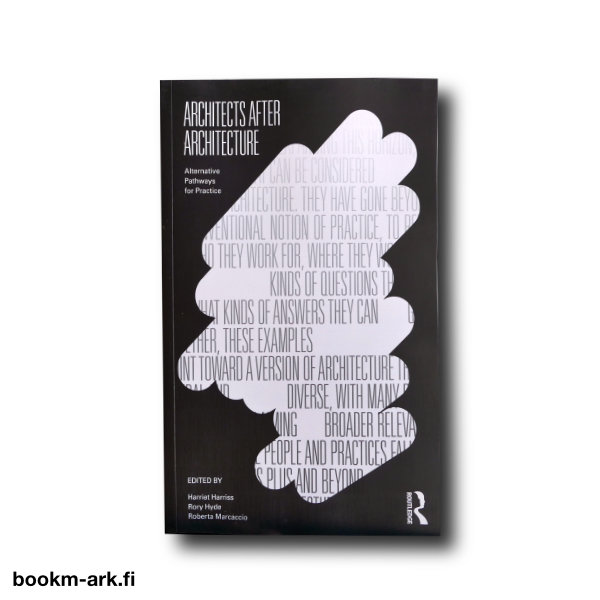Book Review: Architects after Architecture – Guest Critic Pijatta Heinonen 12.03.2021 – Posted in: Book Thoughts
Books are meaningless without readers. This blog post opens a new series that features interesting new titles viewed through a lens of a critical reader. Our first book review is about a polemical new publication Architects after Architecture – Alternative Pathways for Practice (Routledge, 2021), edited by Harriet Harriss, Rory Hyde, and Roberta Marcaccio. Our guest critic is Pijatta Heinonen (b. 1988) who graduated as an architect from Aalto University in 2017, and is currently a doctoral researcher at the Polytechnic University of Catalonia. She is interested in the interactions between architecture and grassroots politics.
Text by Pijatta Heinonen.
Architects after Architecture – Alternative Pathways for Practice (Routledge, 2021) collects together 39 diverse presentations of architects and architectural projects that divert – in small or bigger ways, in discourse or in practice – from the mainstream. About half of the architects (or offices) presented are still working within architecture, and each brings into discussion a different angle regarding the practice. The other half has changed their profession but discusses the relevance and varied application of architectural skills for new purposes. The collection presents a wide scale of themes and ideas that are utilised or that could be reflected on to diversify the sphere of architecture.
Challenges to the mainstream
The first half of presentations brings into discussion various important themes such as architect’s (or architecture’s) privilege and its negotiation toward marginalized people, accessibility of specialized knowledge, social and environmental responsibility, and so on. To promote these themes, several texts discuss also different possibilities to intersect architectural work with others such as research and publishing, facilitation, education and organizing events.
Many of the presentations offer interesting points of view that challenge the ideas and practice behind mainstream design. For example, some consider the ‘normative’ body that is represented as the general user of architecture, and instead bring forth disabled or trans-gender bodies and their often non-represented needs. “Since antiquity, Western architects have presumed that the user of the designed environment is a prototypical body, one that is by default white, able-bodied, cis-gender, heterosexual and male.” (Joel Sanders, p. 85)
Moreover, there are several coherent, well explained presentations of projects that try to do architecture differently. For example, in Nature Playscape future users were directly and recurrently participating in the process of design: “The project speaks to our belief that good public spaces are the product of a design process where many different voices are involved, especially those who are typically excluded” (Interboro, p. 80).
A new kind of starchitect?
These presentations highlight the projects, their process and implementation, and bring ideas visible through examples in practice.
On the other side, there are some presentations that drown themselves to fashionable political speech and miss the point of properly presenting what is being done. They lack creating a visible, verifiable link between words and reality, and end up highlighting the architect(s) instead of discussing the projects and their implementation or impact. Some of such presentations give me a feeling of a new kind of starchitect that this time is formed around an alternative discourse, but still without consideration of the power imbalance the position brings with it. Appropriately, the first half ends in discussing: “What does architecture get from being a ‘profession’? This essay argues, not much, if anything.” (Peggy Deamer, p. 185)
The second half of presentations bring into discussion other spheres and practices such as research, art, technology and public policy. The ex-architects discuss widely the different skills architects learn and can easily apply in different professions and for diverse purposes. For example, being able to visualize complex information, and to think strategically and systematically to find and elaborate solutions, can be useful skills wherever they are put to use. And, many use them to reveal inequality or to advance different social issues.
I felt the need to devise a toolbox for anticolonial struggle, one where architectural analysis could be deployed to understand and dissect the colonial project and expose its weaknesses. (Eyal Weizman, p. 196).
Social impact, social accountability
On the other side, some who have moved on to technology bring forth ideas that architecture could learn and use. They discuss issues such as scale, open source, or testing a design’s usability before it is produced. The issues presented point to areas where architecture is seen lacking in its development of suitable solutions, and thus, in its social impact.
Appropriately, again, the second half ends in discussing the education of architects through a presentation of the Global Free Unit: “Education is no longer a rehearsal for future practice or a space apart from [students’] everyday lives but a part of it. Whilst learning, students are making themselves useful to the wider society they are part of.” (Robert Mull, p. 309)
To conclude, while reading my reactions alternated between exited and bored, respectful and frustrated, but all in all the book left me hopeful and inspired. Hopeful of all the diverse ideas and applications that are being thought and tested, within or without architecture, to further social accountability. Inspired by understanding and reflecting on all the skills and possibilities I as an architect actually do possess, and of all the directions they could possibly take me.
Text by Pijatta Heinonen. Published by Bookmarchitecture Oy by permission of the author.

Would you be interested in reviewing architecture books for our shop blog? Give us a shout, we’d love let our audience hear your voice on this platform. /// Kiinnostaisiko sinua arvioida uusia arkkitehtuurikirjoja blogissamme? Ota yhteyttä, olisi mahtavaa saada äänesi yleisömme kuuluviin tällä alustalla.

